Northern Autumn Arrives, Interplanetary Dust Appears, Evening Planets A-plenty, and the Waning Moon Gives Galaxy Views!
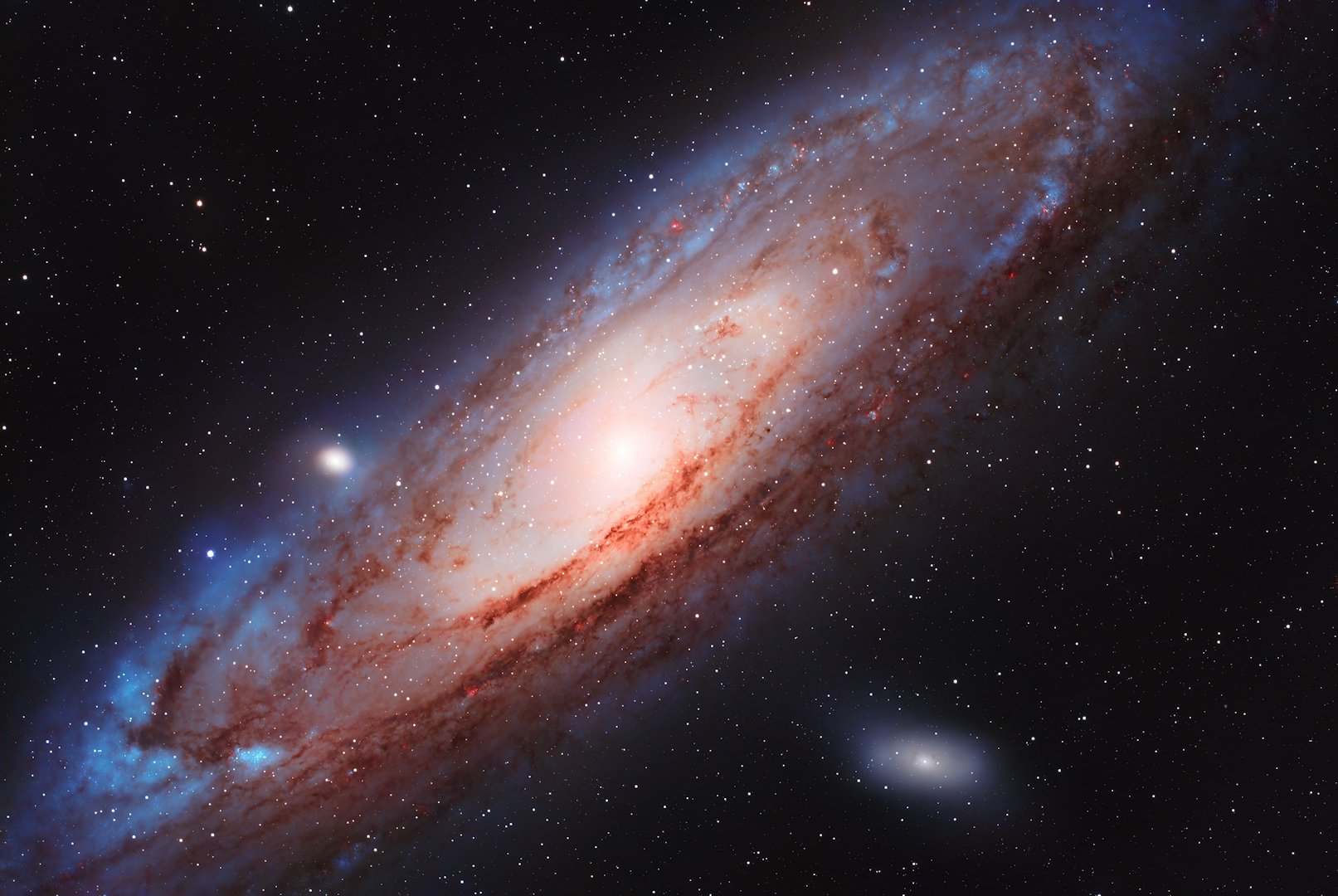
Wayne Parker captured this terrific image of the Andromeda Galaxy (Messier 31) and its small, bright elliptical companions Messier 32 (to the left of the main core) and Messier 110 (to the lower right of the main core) during the annual Starfest Star Party near Mt. forest, Ontario in August, 2022. The image covers about a thumb’s width of sky left-to-right. Wayne manufactures the terrific Skyshed Pod Observatories, www.skyshed.com
Hello, end-of-summer Stargazers!
Here are your Astronomy Skylights for the week of September 18th, 2022 by Chris Vaughan. Feel free to pass this along to your friends and send me your comments, questions, and suggested topics. You can also follow me on Twitter as @astrogeoguy! Unless otherwise noted, all times are expressed in Eastern Time. To subscribe to these emails please click this MailChimp link.
If you’d like me to bring my Digital Starlab portable inflatable planetarium to your school or other daytime or evening event, or deliver a session online, contact me through AstroGeo.ca, and we’ll tour the Universe, or the Earth’s interior, together! My terrific book with John A. Read entitled 110 Things to See With a Telescope is a guide to viewing the deep sky objects in the Messier List – for both beginners and seasoned astronomers. DM me to order a signed copy!
Autumn in the north arrives with the equinox this week, and the morning zodiacal light will be visible from very dark sites. The moon will be absent from evening skies worldwide as it wanes toward Sunday’s new moon. That will allow us to view the big galaxies in the eastern sky – with our eyes or with help. All the outer planets remain observable in evening, although some do rise late. Read on for your Skylights!
Northern Autumn Arrives!
At 9:04 pm Eastern Daylight Time on Thursday, September 22, the September equinox will occur – kicking off autumn in the Northern Hemisphere and spring in the Southern Hemisphere. For those living in other time zones, that time translates to Friday at 01:04 Greenwich Mean Time.
Let’s break down what the equinox is…

As the Earth travels around the sun (completing one orbit every year), our perspective change makes the sun slide continuously eastward across the distant background stars. The circular path it traces around the celestial sphere is called the ecliptic. Ancient skywatchers noted that, in the course of one year, the sun passed through the same twelve (well, thirteen actually) constellations – avoiding all others. Those “special constellations” became the zodiac. The sun’s time spent within each zodiac constellation fell onto the same range of dates – leading to the astrology sun sign idea that many still follow.
The sun doesn’t preciselly “re-trace its steps” every year. You see, the Earth, as a “spinning top”, is precessing because it is not a perfect sphere, and because the sun and moon tug on those imperfections. Earth’s two polar axes (one north and one south) each point to a point in the sky called the celestial pole. Earth’s northern axis is currently aimed 27.5 arc-minutes (about the moon’s apparent diameter) away from Polaris, the North Star. That’s close enough for regular folks to use Polaris as the north celestial pole, but astronomers’ telescopes need to be aligned precisely to the true pole.
Earth’s precession has, and will continue to, trace out a circle of 47° in diameter in the stars – over an interval that repeats every 25,765 years. During that cycle the celestial pole circle passes through the constellations of Ursa Minor (the Little Bear), Cepheus (the King), and the northern parts of Cygnus (the Swan), Lyra (the Harp), and Hercules. Very bright Vega will be the pole star again around 13,500 AD. The ring almost completely encloses the constellation of Draco (the Dragon). In fact, the pole stars of the sun and many of the major planets are part of Draco.
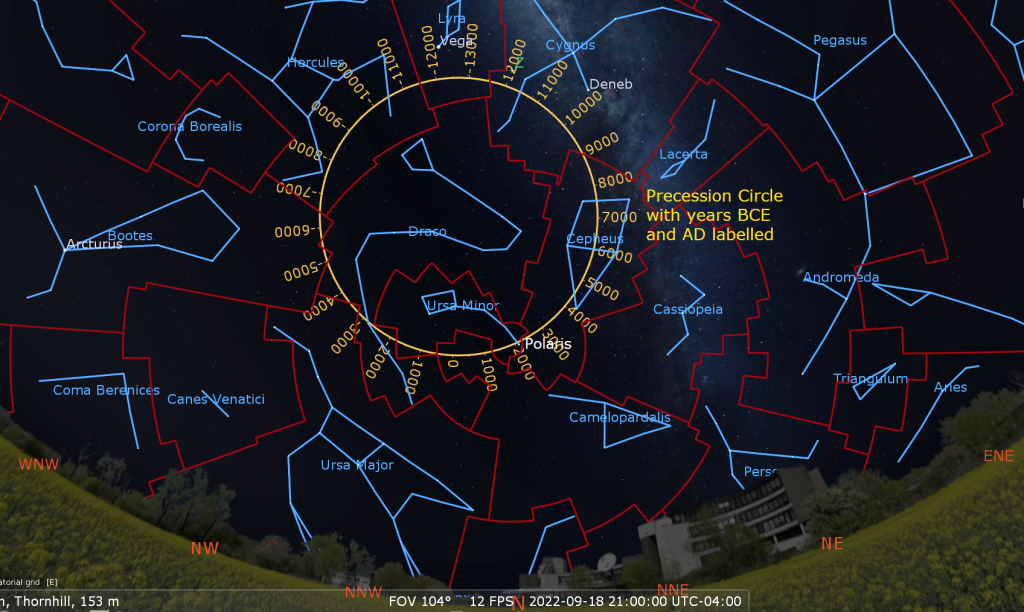
The precession also makes the sun creep westward along the ecliptic by 50.2 arc-seconds per year, or about a thumb’s diameter every century. Several thousand years ago, the equinoxes were called the First Point of Aries and the First Point of Libra – because those constellations hosted the sun in March and September. Since then, precession has caused the two equinox points to shift by one zodiac constellation to the west.
Okay – let’s get back to understanding the September equinox…
The Earth’s axis of rotation is tilted 23.5° away from the ecliptic – so an imaginary circle painted on the sky directly overhead of our equator runs through a different group of stars than does the ecliptic. In fact, that celestial equator divides the celestial sphere into two great bowls, the Northern Hemisphere stars and the Southern Hemisphere stars. Since the Earth’s equator is to the south for observers in the Northern Hemisphere, the celestial equator is always in the southern part of our sky, and it runs from the eastern horizon to the western horizon.

You can think of the equator and ecliptic circles as two hula hoops sharing the same centre – us. Since one hoop is tilted by 23.5° compared to the other one, the two circles only intersect at two spots in the sky, one in western Virgo (the Maiden) and the other in western Pisces (the Fishes). The sun reaches those spots during the third weeks of March and September, respectively. Another way of thinking about it is that half of the ecliptic runs through stars in the southern celestial hemisphere, and the other half runs through northern stars – so the sun spends half of the year among northern stars and the other half among southern stars.
At the moment of an equinox, the sun is at one of the intersection points – as if it is “stepping over” the equator. The full disk of the sun takes about 13 hours to cross the equator – but we define the equinox as the precise moment when the centre of the sun slips across. The equinoxes and solstices are global events. Just add or subtract the appropriate number of hours to determine when northern autumn will begin for your own time zone.
On the September, or autumnal, equinox the sun is passing into the southern bowl of the sky. Six months later, on the vernal equinox, it will cross the celestial equator at the other intersection point and re-enter the northern bowl of the sky. At that moment, spring will begin for the Northern Hemisphere. (I like to avoid using the seasonal terms “vernal” and “autumnal” because those seasons are swapped for people living in the Southern Hemisphere.) The solstices occur about mid-way between the equinoxes – in late June and December.
An equinox comes with several interesting effects. At either equinox, the sun rises due east and sets due west. For the six months following the September equinox, the sun will spend all of each day among the Southern Hemisphere stars, and climb high in the sky for the lucky folks who live there! The higher sun will take more daylight hours to cross the sky and will deliver more highly-concentrated solar radiation, producing warmer weather. (Compare the intensity of a flashlight’s light when it’s beamed straight at a wall versus obliquely at the wall. The bright circle of light gets weaker when it’s spread into an oval.) During the same months, North Americans, Europeans, and Asians have to accept shorter, colder days and longer nights (which are great for warmly dressed astronomers). On the day of the equinox, everyone on Earth experiences 12 hours each of day-time and night-time (unless you live near the North Pole where the sun won’t drop low enough below the horizon to darken the sky). This is where the term equinox, Latin for “equal night”, comes from.
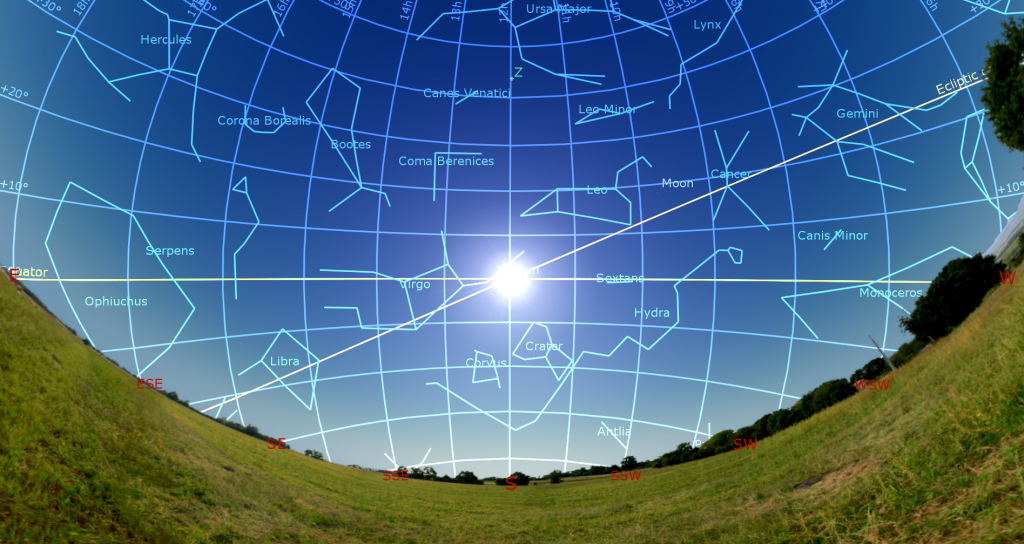
The nights around the equinoxes offer a higher likelihood of the Northern Lights, or aurorae, at high northern and southern latitudes. Just as two bar magnets lined up with their poles in the same direction repel one another strongly, the Earth’s magnetic field repels the sun’s field. At the equinoxes, the Earth’s axis tilts partly sideways compared to the sun, so the two “magnets” aren’t lined up as well, reducing Earth’s ability to deflect the sun’s field and the charged particles that trigger aurorae in our upper atmosphere.
At this time in September every year, the Earth is travelling almost directly towards the stars that mark the upraised club of Orion (the Hunter) and the toes of Gemini (the Twins). In a few weeks, that geometry will produce the “bugs on a windshield” effect when the Orionids meteor shower particles strike the Earth’s upper atmosphere and produce the streaks of light we see. Also at this time, Earth is travelling almost directly away from the stars of Sagittarius (the Archer) and Ophiuchus (the Water-Bearer).
What I’ve described above is the astronomical definition of the seasons. The meteorological definition declares that northern autumn begins on September 1 and ends on November 30 – and so on through the year for winter, spring, and summer.
The Moon
This is the darkest week of the lunar month worldwide. While the waning crescent moon is reducing its angle from the morning sun, the evening and midnight skies are moonless – ideal for viewing fainter deep sky objects. I’ll share some suggested things to view below.
Tonight (Sunday) the pretty moon will rise half an hour after midnight among the stars of Gemini (the Twins) and then it will linger into the morning daytime sky. Between about 2 am local time and dawn on Tuesday morning, early risers can look in the eastern sky for the pretty, slender crescent of the old moon shining just below Gemini’s bright star, Pollux. Pollux’ “twin”, the star Castor, will be positioned several finger widths above them. The scene will make a lovely photo opportunity when composed with some interesting landscape.

Between about 3 am local time and dawn on Wednesday morning, look in the eastern sky for the very slim crescent moon shining several finger widths to the upper left (or 4 degrees to the celestial north) of the big open star cluster known as the Beehive, Praesepe, and Messier 44. The moon and cluster will be close enough to share the field of binoculars, but you’ll see more of the “bees” if you tuck the moon just out of sight on the upper left.
The moon will spend Thursday to Saturday traversing Leo (the Lion). On Saturday morning before sunrise, its extremely thin crescent will smile like the Cheshire Cat above the very bright dot of Venus. On Sunday morning, you might even glimpse the sliver of moon sitting a few finger widths to the lower left of Venus.
On Sunday at 5:54 pm EDT or 2:54 pm PDT and 21:54 GMT, the moon will officially reach its new moon phase. At that time our natural satellite will be located in Virgo (the Maiden), 2.5 degrees north of the sun. While new, the moon is travelling in space between Earth and the sun. Since sunlight can only illuminate the far side of the moon, and the moon is in the same region of the sky as the sun, it becomes completely hidden from view from anywhere on Earth for about a day. After the new moon phase, Earth’s celestial night-light will return to shine as a young crescent in the western evening sky from next Monday onwards.
Morning Zodiacal Light for Mid-Northern Observers
During autumn at mid-northern latitudes every year, the ecliptic extends nearly vertically upward from the eastern horizon before dawn. That geometry favors the appearance of the faint zodiacal light in the eastern sky for about half an hour before dawn on moonless mornings. Zodiacal light is sunlight scattered by interplanetary particles that are concentrated in the plane of the solar system – the same type of material that produces meteor showers. It is more readily seen in areas free of urban light pollution. For observers at low latitudes, the ecliptic is nearly vertical all year round, making the light a frequent phenomenon. Sadly, observers north of 60°N latitude miss out.

If your location favours it, between Friday, September 23 and the full moon on October 9, look for a broad wedge of faint light extending upwards from the eastern horizon and centered on the ecliptic. It will be strongest in the lower third of the sky, below the twin stars Castor and Pollux. Try taking a long exposure photograph to capture it. Don’t confuse the zodiacal light with the Milky Way, which is positioned nearby in the southeastern sky.
The Planets
This week, very bright Venus will be visible, with difficulty, shining just above the eastern horizon before sunrise. It is descending sunward for a solar conjunction in mid-October. The outer planets, from Mars to Neptune, will all be shining in the evening sky.
With the arrival of earlier sunsets, the medium-bright, yellowish dot of Saturn should become visible in the lower part of the southeastern sky shortly after 8 pm local time. The ringed planet will be creeping slowly westward above the medium-bright stars of Capricornus (the Sea-Goat) until late October. Saturn will cross the sky during the night and set in the west-southwest before about 3:30 am local time. Since the planets always look their best in a telescope when they are higher in the sky, Saturn’s peak viewing time will be around 10:30 pm, when it will shine in the south – but you can enjoy less-than-perfect views from dusk onwards.
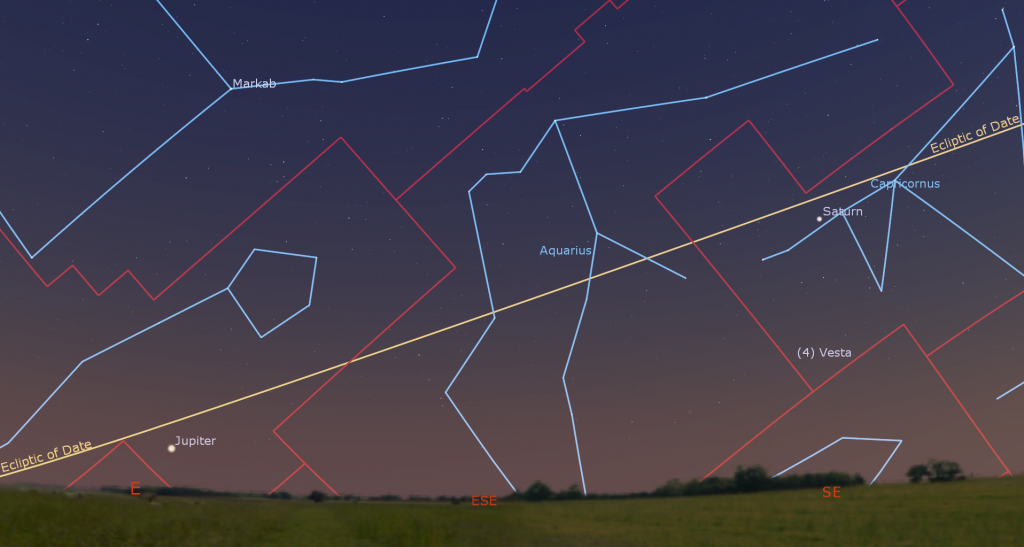
Even a small telescope will show Saturn’s subtly banded globe encircled by its rings, which will become more edge-on to us every year until the spring of 2025. This year Saturn’s southern polar region has already extended well beyond the ring plane. See if you can see the Cassini Division, the narrow, dark gap that separates Saturn’s main inner ring from its bright outer one. Over the coming weeks, Saturn’s slide to the west of the anti-solar point will cause the planet’s globe to cast a widening wedge of dark shadow onto the rings where they emerge from behind the eastern limb of the planet. Where you find the shadow will depend on how your telescope flips and/or mirrors the view. In a refractor or SCT telescope, it’s to the upper right. In a Newtonian reflector, it will be towards lower right. An equatorial mount will rotate the scene, too. Take long looks and wait for moments of perfect clarity.
A small telescope can also show several of Saturn’s moons – especially its largest, brightest moon, Titan! From here on Earth, Saturn’s axial tilt of 26.7° lets us see the top of its ring plane, and allows its brighter moons to array themselves all around the planet. Saturn’s largest and brightest moon Titan never wanders more than five times the width of Saturn’s rings from the planet. The much fainter moon named Iapetus can stray up to twelve times the ring width during its 80-day orbit of Saturn. The next brightest moons Rhea, Dione, Tethys, Enceladus, and Mimas all stay within one ring-width of Saturn. During evening this week, Titan will migrate counter-clockwise around Saturn, moving from the upper right (or celestial west) of the planet tonight (Sunday) to the lower left (or celestial east) the planet next Sunday. (Remember that your telescope might flip that view around.) How many of the moons can you see in your telescope?
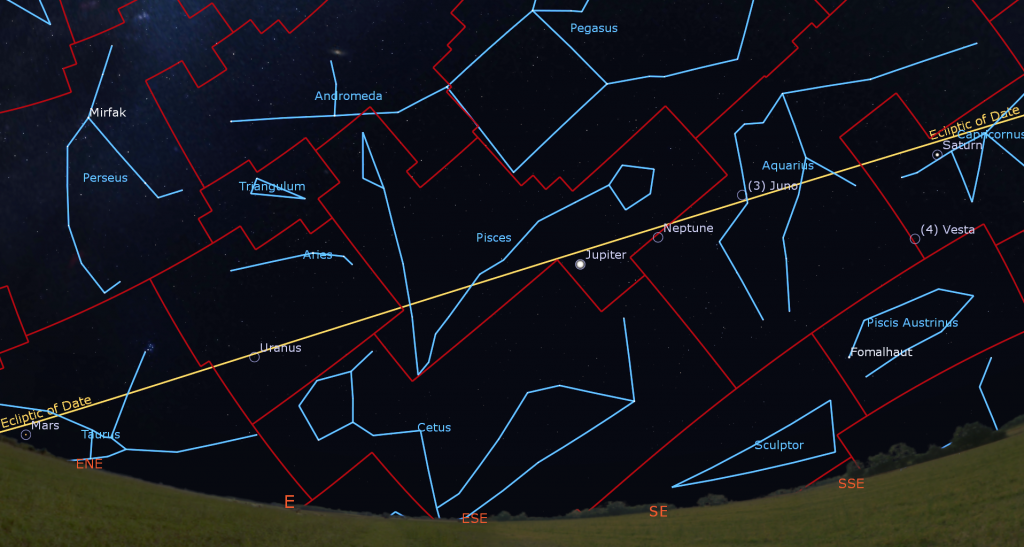
This week, extremely bright, white dot of Jupiter should clear the eastern rooftops by around 8:30 pm local time, and then spend the night shining below the modest stars of Pisces (the Fishes), with 17 times fainter Saturn well off to its right. Jupiter will climb highest at 1:30 am local time, but it will look reasonably good in any telescope after 9:30 pm. Early risers can spot the planet shining just above the western horizon before sunrise.
Good binoculars will show Jupiter’s disk flanked by its row of four Galilean moons Io, Europa, Ganymede, and Callisto, which complete orbits of the planet every 1.7, 3.6, 7.2, and 16.7 days, respectively. If you see fewer than four of them, then one or more is crossing in front of or behind Jupiter – or lurking in Jupiter’s dark shadow – or two moons are occulting one another. Any size of telescope will show Jupiter’s dark bands running parallel its equator.
Because Jupiter rotates once every 10 Earth-hours, anyone can use a good backyard telescope to watch the pale-looking Great Red Spot cross the planet every 2nd or 3rd night. For observers in the Americas, the GRS will cross Jupiter’s disk on Sunday, Wednesday, and Friday evening, and also before dawn on Tuesday, Friday, and Sunday morning. If you have any coloured filters for your telescope, try enhancing the GRS with them.
The small, black shadows of Jupiter’s Galilean moons are visible through a good backyard telescope when they cross the planet’s disk. It happens more often as we approach Jupiter’s opposition, which will be next Monday. Between 8:10 and 11 pm EDT on Tuesday evening, observers in the Americas with telescopes can watch the large, black shadow of Ganymede cross Jupiter’s disk. That start time corresponds to 7:10 pm in the Central Time zone, and 00:10 GMT on September 21. For observers in western USA and Canada, only the later stages of the event will be visible while Jupiter climbs the eastern sky after dusk. Europa’s small shadow will cross on Wednesday morning between 3 and 5:30 am EDT. Io’s shadow will cross on Thursday morning between 3:25 and 5:35 am EDT, and again on Friday (alongside the Great Red Spot!) from 9:55 pm to midnight EDT.
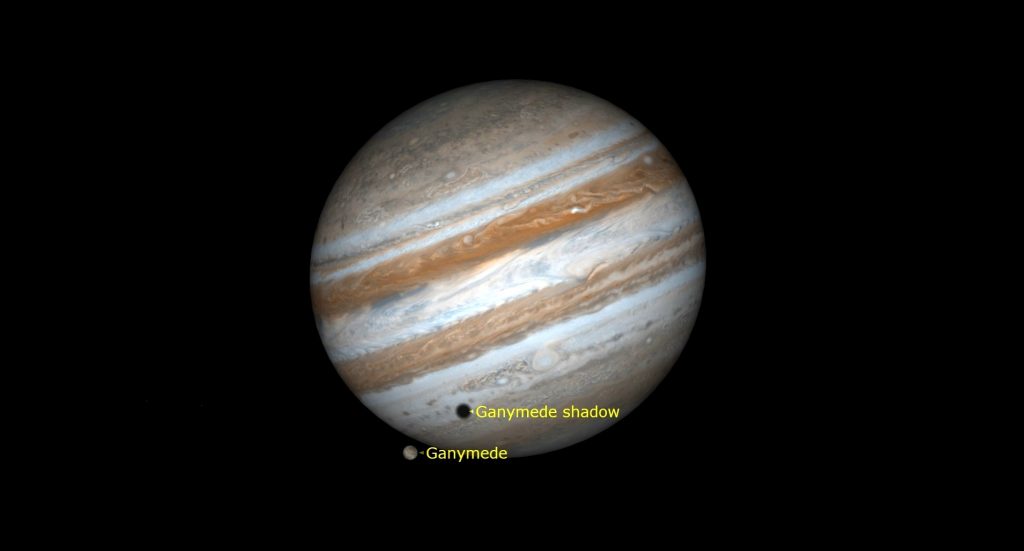
Neptune is positioned in the sky between Jupiter and Saturn. This month, the distant planet’s faint, blue speck will be located a generous fist’s diameter to Jupiter’s upper right, and two finger widths to the upper right (or 2.3° to the celestial west-southwest) of a small star named 20 Piscium. Last Friday, the blue planet reached opposition, its closest point to Earth for this year. Neptune is visible all night long in backyard telescopes. Good binoculars will show it, too – if your sky is very dark. Your best views will come after 9 pm local time, when the blue planet has risen higher. Around opposition, Neptune’s apparent disk size will peak at 2.4 arc-seconds and its large moon Triton will be the most visible.
Uranus is within reach of binoculars in a dark, moonless sky, and in any telescope. The blue-green speck of the planet is located a generous fist’s width to the upper right (or 12° to the celestial southwest) of the Pleiades star cluster. Closer guideposts to Uranus are several medium-bright stars named Botein (or Delta Arietis), Al Butain II (or Rho Arietis), and Sigma Arietis which will appear several finger widths from Uranus. Those stars mark the feet of the Ram. The magnitude 5.7 planet will be high enough for telescope-viewing, in the lower part of the eastern sky, by 11 pm local time this week.
This week, the medium-bright, reddish dot of Mars will rise above the east-northeastern horizon before 11 pm local time and will deliver nice views in a backyard telescope by about 1 am local time. In a telescope, Mars will show a small, 86%-illuminated disk. Watch for the bright reddish star Aldebaran positioned a generous palm’s width to Mars’ right (or celestial southwest). Mars will be brightening and growing larger as Earth’s faster orbit draws us closer to it over the coming months. We’re 128 million km (or 7.1 light-minutes) away from it this week.
Giant Galaxy Gazing on Moonless Nights
‘Tis the season to look for the farthest object a human eyeball can see without help* – the Andromeda Galaxy, or Messier 31. This large spiral galaxy is a big sister to our own Milky Way galaxy. It sits 2.5 million light-years away from our sun, meaning that its stars’ light has been journeying for that length of time. And, if there are alien astronomers living there and looking back at us, they are seeing our solar system as we appeared 2.5 million years ago!
In mid-September, the Andromeda Galaxy sits just less than halfway up the east-northeastern sky at 9 pm local time. (It will be higher later on.) To locate it, you can first find the medium-bright star Mirach. It’s the second star when hopping left (celestial east) from Alpheratz, which marks the eastern corner star of the Great Square of Pegasus. Then look for a dimmer star shining a few finger widths above (or 4° NE of) Mirach. The Andromeda Galaxy is higher again by that same distance. Alternatively, you can use the highest three stars of the W-shaped constellation Cassiopeia (the Queen). They form an arrow that points directly at M31.

Under dark skies, using your unaided eyes only, you should be able to see a faint fuzzy patch that is elongated left to right. Try directing your attention a little ways away from the galaxy and it will brighten – the averted vision trick! The galaxy spans six full moon diameters across the sky, but only its bright core and the surrounding, inner halo are usually seen visually. The galaxy is quite easy to see with binoculars. The giant galaxy is a cool object to see! Let me know if you view it.
Because telescopes have fields of view that are too narrow to see the entire galaxy, they’ll generally only show you Andromeda’s bright core. While looking, see if you can make out M31’s two small, fuzzy-looking companions, the small elliptical galaxies designated M32 and M110. M32 is closer to the main galaxy’s core and it situated just to the lower right (or to the celestial south). M110 is above (or northeast of) the main core and is slightly farther away. At 2.49 million light-years, M32 is closer to us than the Andromeda Galaxy; while M110 is 200,000 light-years farther away. (Most telescopes will flip and/or mirror image those directions.)
*Another large galaxy, called Messier 33 in Triangulum (the Triangle), is 2.75 million light-years away. Observers with very keen eyes under very dark sky conditions can sometimes see it, too – setting the record. This galaxy is tougher because it is oriented nearly face-on to Earth – so its light is spread across a large patch of sky (equal to 1.5 full moon diameters), making it dimmer overall. It sits only 1.3 fist diameters below M31, a palm’s width below the star Mirach.

Diving into Delphinus
If you missed last week’s look at the cute little constellation named Delphinus (the Dolphin), I posted it here here.
Public Astro-Themed Events
Every Monday evening, York University’s Allan I. Carswell Observatory runs an online star party – broadcasting views from four telescopes/cameras, answering viewer questions, and taking requests! Details are here. They host in-person viewing on the first clear Wednesday night each month. Other Wednesdays they stream views online via the observatory YouTube channel. Details are here.
On Tuesday, September 20 from 4 to 5 pm EDT, the Toronto Public Library will feature a free, online public lecture by Margaret Ikape, a PhD candidate in the department of Astronomy and Astrophysics at the University of Toronto. She’ll speak on Understanding the Universe. More information and the registration link are here.
On Wednesday evening, September 21 at 7:30 pm EDT, the RASC Toronto Centre will live stream their monthly Speakers Night meeting. This month will feature Julie Tomé of the Royal Ontario Museum. Her talk is titled “Mom, can you do this every summer?”, about her experiences as Astronomer in Residence this summer at Killarney Provincial Park. Everyone is invited to watch the presentation live on the RASC Toronto Centre YouTube channel. Details are here.
On Thursday evening, September 22, celebrate the September equinox with the Toronto Public Library! Professor John Percy, Professor Emeritus of Astronomy, University of Toronto will present a free public talk called “Astrobiology: Life and the Universe” – a non-technical, profusely-illustrated presentation reviewing the indirect evidence for life elsewhere in the universe, as well as the present and future methods for finding more direct evidence. Details and the link to register are here.
My free, family-friendly Insider’s Guide to the Galaxy webcasts with Samantha Jewett of RASC National returns on Tuesday, September 27 at 3:30 pm EDT, when we’ll finish our look at variable stars! Plus, we’ll continue with our Messier Objects observing certificate program – autumn objects. You can find more details and the schedule of future sessions here.
Don’t forget to take advantage of the astronomy-themed YouTube videos posted by RASC Toronto Centre and RASC Canada.
Keep looking up, and enjoy the sky when you do. I love questions and requests. Send me some!
One Response
Great article Chris! Very informative!
Thanks very much for the shout-out!
CS!
Wayne